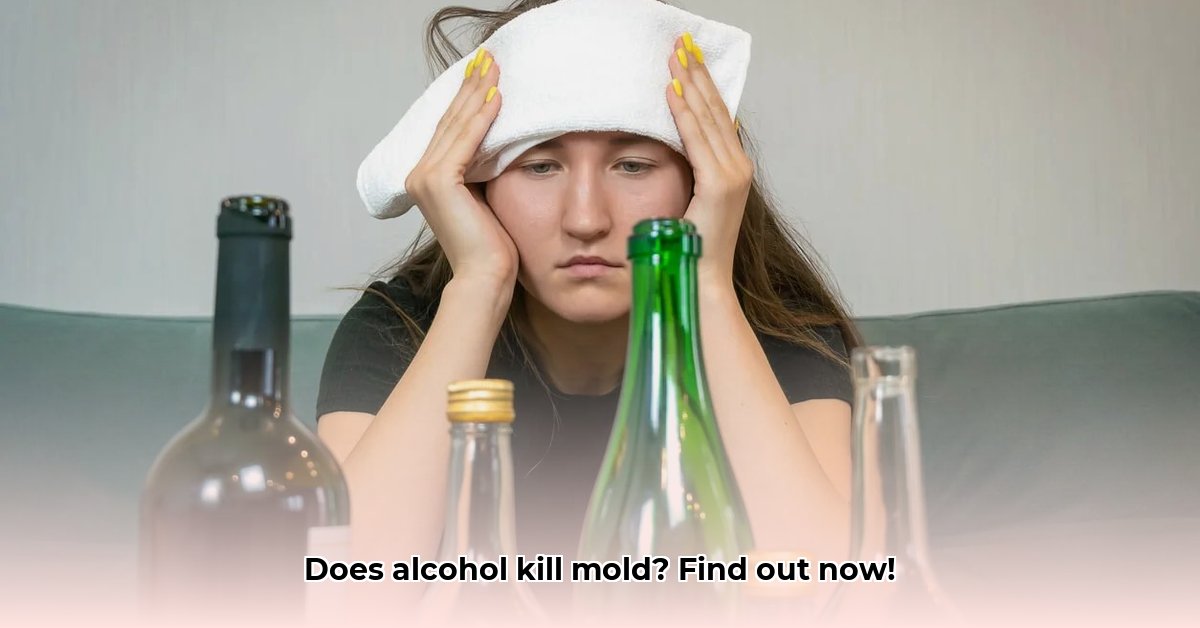Mold can be a frustrating problem in homes. Before reaching for harsh chemicals, many wonder if a common household item like alcohol can effectively kill mold. This guide provides a clear understanding of when alcohol can be a useful tool, its limitations, and when professional help is necessary. For more in-depth information, check out this helpful guide: Mold Removal Guide.
Understanding Alcohol’s Role in Mold Removal
Let’s address the core question: Can alcohol eliminate mold? The response hinges on several factors. While rubbing alcohol can address some surface mold, it’s not a universal solution. It’s a helpful tool within a broader cleaning strategy, most effective for surface-level issues.
Limitations of Alcohol: Not a Mold Exterminator
Isopropyl alcohol, or rubbing alcohol, can be effective against mold on specific surfaces. However, its effectiveness is limited to the surface of smooth, non-porous materials like sealed tile or glass. Mold often penetrates porous materials like wood, grout, and drywall, hiding from the alcohol. Furthermore, alcohol won’t eradicate mold spores, which are microscopic seeds that can quickly lead to new mold colonies. The root systems of mold, known as hyphae, can also remain intact even after the surface mold is killed, allowing for regrowth.
Choosing the Right Type of Alcohol
A 70% concentration of isopropyl alcohol is generally recommended. This concentration strikes a balance between effectiveness and preventing rapid evaporation. Higher concentrations evaporate too quickly to be effective. Ethyl alcohol, found in alcoholic beverages, is less effective than isopropyl alcohol for mold removal due to its lower potency and differing chemical properties. Denatured alcohol, while effective, contains additives that can leave residues.
When Alcohol Can Be a Helpful Cleaning Solution
Using a 70% isopropyl alcohol solution can be beneficial for minor surface mold on sealed countertops, bathroom fixtures, or other non-porous surfaces where mold is newly formed and hasn’t penetrated deeply. However, addressing the root cause of the mold—excess moisture—is essential. Alcohol is best used as a final cleaning step, not as the primary method for fighting mold. Think of it as a quick touch-up rather than a long-term cure.
Alternatives to Alcohol: Effective Treatments for Mold
More effective alternatives to alcohol for dealing with mold include vinegar, with its acidic properties, and bleach, with its powerful oxidizing action. Vinegar can kill up to 80% of mold species. These options can penetrate and destroy mold more effectively, even in porous materials. However, bleach is corrosive and toxic, requiring careful handling, and can discolor surfaces, while vinegar can damage certain surfaces like natural stone. Other alternatives include hydrogen peroxide, baking soda, borax, and specialized mold-killing products.
Know When to Call a Mold Remediation Professional
For significant mold problems (larger than 10 square feet), persistent mold, mold growth in hard-to-reach areas, or when dealing with porous materials, it’s best to consult a professional mold remediation service. These experts have the necessary equipment, knowledge, and tools to safely and completely remove mold. They also understand local building codes and regulations. Attempting to handle large infestations yourself can spread mold spores and worsen the problem.
Step-by-Step Guide to Using Alcohol for Mold Removal (Use Caution)
If you choose to use alcohol for a small, surface-level mold problem, follow these steps carefully:
- Safety First: Wear protective gloves, a respiratory mask, and eye protection. Keep alcohol away from open flames or heat sources, as it is flammable. Ensure adequate ventilation to avoid inhaling fumes.
- Careful Assessment: Ensure the mold is only on the surface and not embedded in a porous material. If unsure, seek professional help.
- Ventilation is Crucial: Open windows and use fans to ensure good ventilation.
- Apply Alcohol Sparingly: Spray the affected area with 70% isopropyl alcohol, applying only a light coating. Avoid oversaturation.
- Gentle Scrubbing: Gently scrub the area with a soft brush or sponge. Avoid using abrasive materials that can damage the surface.
- Wipe it Down: Wipe the area clean with a damp, clean cloth.
- Thorough Drying: Allow the area to air dry completely, as moisture encourages mold growth. Use a fan or dehumidifier to speed up the drying process.
- Address the Source: Identify and fix the source of the moisture that caused the mold. This could involve repairing leaks, improving ventilation, or reducing humidity.
Pros and Cons of Using Alcohol as a Mold Remover
| Pros | Cons |
|---|---|
| Relatively inexpensive and easily accessible | Only effective on surface mold on non-porous materials |
| Simple to use for very minor mold issues | Flammable; requires careful handling and safety precautions |
| Low environmental impact compared to bleach | Won’t remove mold spores, leading to potential regrowth |
| Can be a helpful final cleaning step | Can cause skin and eye irritation, especially higher concentrations |
| Dries quickly, minimizing moisture | Ineffective against deeply rooted mold or large infestations |
How to Effectively Use Isopropyl Alcohol for Mold Removal on Non-Porous Surfaces
Isopropyl alcohol (IPA) can effectively kill surface mold on non-porous surfaces, but it’s not a complete solution. It won’t eliminate mold roots, penetrate porous surfaces, or address underlying moisture issues. IPA is best suited for small mold infestations on surfaces like glass, tile, or sealed metal. For larger infestations or porous materials, professional remediation is necessary. Addressing moisture issues is always a priority.
Step-by-Step Guide:
- Safety First: Always wear gloves, eye protection, and a respiratory mask. Work in a well-ventilated area. IPA is flammable, so avoid open flames and sparks.
- Assess the Situation: Is the area affected small (less than 1 square foot) and only on non-porous materials? If not, consider professional help.
- Prepare the Surface: Clean the area to remove loose debris, dust, and visible mold with a damp cloth.
- Apply the IPA: Use a 70% or higher concentration of IPA. Spray directly onto the mold or use a clean cloth for application, ensuring thorough saturation.
- Allow Sufficient Contact Time: Let the IPA sit for at least 10-15 minutes to effectively kill the surface mold.
- Scrub and Rinse: Gently scrub the area with a clean brush or cloth to remove dead mold and residue, and then rinse thoroughly with clean water.
- Dry Thoroughly: Ensure the surface is completely dry using a clean cloth or a fan to prevent future mold growth.
While effective on the surface, IPA has limitations. It only addresses surface mold, leaving mold roots and spores behind. Therefore, addressing the source of moisture is paramount for long-term mold prevention. IPA’s quick evaporation can limit its contact time with mold if not applied correctly; consider reapplying the solution during the contact time.
For significant mold problems, consult a professional. Hidden mold behind walls or in porous materials poses real health risks and requires expert removal. Black mold (Stachybotrys chartarum) demands professional help due to its toxicity. Other options for surface mold removal include diluted bleach, vinegar, and hydrogen peroxide, but these also have their limitations and should be used with caution.
Proven Tactics To Prevent Mold Growth After Alcohol Treatment
Alcohol effectively kills surface mold on non-porous surfaces, with 70% concentrations being the most effective. However, alcohol is not a complete solution. It does not eliminate mold spores or address underlying moisture problems, which are the root cause of mold growth. Mold can return quickly if these factors are not addressed.
Proven Tactics To Prevent Mold Growth After Alcohol Treatment involve addressing moisture issues, improving ventilation, and implementing preventative maintenance. Prioritize professional help for extensive mold infestations or mold in porous materials, as DIY methods have limitations.
Here are some tactics:
- Identify and Eliminate Moisture Sources: This is the most vital step. Repair leaky pipes, roofs, and windows. Improve drainage around the foundation of your home.
- Thorough Cleaning: Vacuum the surface using a HEPA-filter vacuum to remove loose spores and debris after cleaning with alcohol. Clean surrounding areas as well to prevent cross-contamination.
- Preventative Maintenance: Regularly clean and inspect areas prone to mold growth, such as bathrooms, kitchens, and basements.
- Ventilation Improvements: Ensure good airflow in bathrooms, kitchens, and other moisture-prone areas. Use exhaust fans during and after showering or cooking, and open windows when possible.
- Regular Dehumidification: Maintain humidity levels between 30-50% to inhibit mold growth. Use a dehumidifier, especially in damp basements or crawl spaces.
- Mold-Resistant Materials: Use mold-resistant drywall and paint in areas prone to moisture.
- Proper Insulation: Ensure adequate insulation to prevent condensation buildup, especially in attics and basements.
- Professional Help (When Needed): Large infestations or mold in porous materials require professional remediation.
Remember, prevention is better than cure; addressing moisture is key to long-term mold control. Regular monitoring and proactive maintenance are essential for preventing mold from returning.
Expert Tips For Using Alcohol To Kill Mold Safely
Isopropyl alcohol (70%) and ethanol (70%) can kill surface mold on non-porous surfaces. However
- Why an App Appeared on My Phone Unexpectedly - November 22, 2025
- How to Stop Unwanted Apps from Automatically Downloading on Android - November 21, 2025
- Why Are Android Games Installing Themselves on Your Phone? - November 20, 2025










